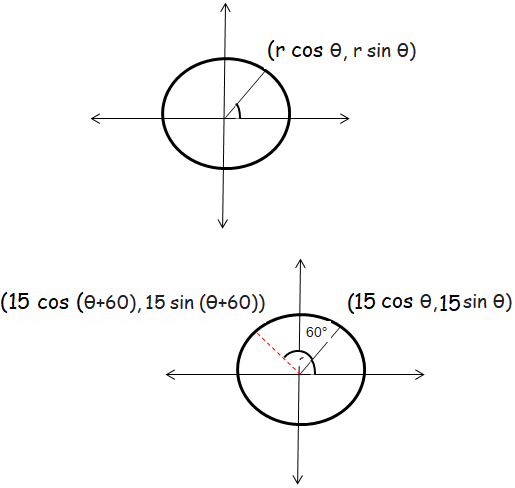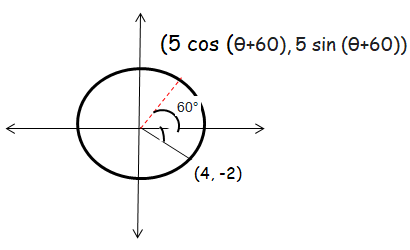NEW POSITION AFTER ROTATIONAL TRANSFORMATION BY GIVEN DEGREE
Subscribe to our ▶️ YouTube channel 🔴 for the latest videos, updates, and tips.
Problem 1 :
Point A (9, 12) rotates around the origin O in the plane through 60 degree in the anticlockwise direction to the new position B. Find the coordinates of the point B.
Solution :
Finding radius from the initial position lies on the circle (9, 12).
r = √92 + 122
r = √81+144
r = √225
r = 15
With radius 15 units and angle measure of 60 degree, the new position will be at

15 cos (θ + 60) = 15 [ cos θ cos 60 - sin θ sin 60]
= 15[cos θ (1/2) - sin θ(√3/2)]
= 15cos θ (1/2) - 15sin θ(√3/2)
= 9(1/2) - 12(√3/2)
= (3/2)(3 - 4√3)
15 sin (θ + 60) = 15 [ sin θ cos 60 + cos θ sin 60]
= 15[sin θ(1/2) + cos θ(√3/2)]
= 15 sin θ (1/2) + 15 cos θ(√3/2)
= 12(1/2) + 9(√3/2)
= 3(4 + 3√3)
So, the new position will be at [(3/2)(3 - 4√3), (3/2)(4 + 3√3)]
Problem 2 :
Determine the image of the point A(4, -3) after the rotation of 60 degree about the origin.
Solution :
Finding radius from the initial position lies on the circle (4, -3).
r = √42 + (-3)2
r = √16+9
r = √25
r = 5

5 cos (θ + 60) = 5 [ cos θ cos 60 - sin θ sin 60]
= 5[cos θ (1/2) - sin θ(√3/2)]
= 5cos θ (1/2) - 5sin θ(√3/2)
= 4(1/2) - (-3)(√3/2)
= (2, 3√3/2)
5 sin (θ + 60) = 5 [ sin θ cos 60 + cos θ sin 60]
= 5[sin θ(1/2) + cos θ(√3/2)]
= 5 sin θ (1/2) + 5 cos θ(√3/2)
= 4(1/2) + (-3)(√3/2)
= (2, -3√3/2)
So, the new position will be at [(3/2)(3 - 4√3), (3/2)(4 + 3√3)]
Subscribe to our ▶️ YouTube channel 🔴 for the latest videos, updates, and tips.
Recent Articles
-
Finding Range of Values Inequality Problems
May 21, 24 08:51 PM
Finding Range of Values Inequality Problems -
Solving Two Step Inequality Word Problems
May 21, 24 08:51 AM
Solving Two Step Inequality Word Problems -
Exponential Function Context and Data Modeling
May 20, 24 10:45 PM
Exponential Function Context and Data Modeling